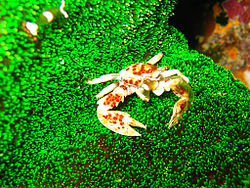| Cryptodendrum | |
|---|---|
 | |
| C. adhaesium showing the distinctive edge tentacles | |
| Scientific classification | |
| Domain: | Eukaryota |
| Kingdom: | Animalia |
| Phylum: | Cnidaria |
| Subphylum: | Anthozoa |
| Class: | Hexacorallia |
| Order: | Actiniaria |
| Family: | Thalassianthidae |
| Genus: | Cryptodendrum Klunzinger, 1877 |
| Species: | C. adhaesivum |
| Binomial name | |
| Cryptodendrum adhaesivum (Klunzinger, 1877) | |
| Synonyms | |
(Genus)
(Species)
| |
Cryptodendrum is a genus of sea anemones in the family Thalassianthidae. It is monotypic with a single species, Cryptodendrum adhaesivum, also commonly known as the adhesive anemone, pizza anemone, and nap-edged anemone. Like all symbiotic anemones it hosts zooxanthellae , symbiotic algae that help feed their host. [1]

